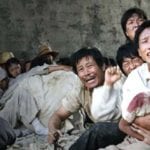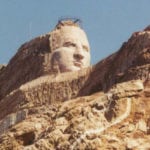 Mysteries
Mysteries  Mysteries
Mysteries  Creepy
Creepy 10 Scary Tales from the Middle Ages That’ll Keep You up at Night
 Humans
Humans 10 One-of-a-kind People the World Said Goodbye to in July 2024
 Movies and TV
Movies and TV 10 Holiday Movies Released at Odd Times of the Year
 Politics
Politics 10 Countries Where Religion and Politics Are Inseparable
 Weird Stuff
Weird Stuff 10 Freaky Times When Famous Body Parts Were Stolen
 Miscellaneous
Miscellaneous 10 Interesting Things Manufacturers Stopped Making and Why
 Gaming
Gaming 10 Funny Tutorials in Games
 History
History 10 Fascinating Little-Known Events in Mexican History
 Facts
Facts 10 Things You May Not Know about the Statue of Liberty
 Mysteries
Mysteries 10 Devastating Missing Child Cases That Remain Unsolved
 Creepy
Creepy 10 Scary Tales from the Middle Ages That’ll Keep You up at Night
 Humans
Humans 10 One-of-a-kind People the World Said Goodbye to in July 2024
Who's Behind Listverse?

Jamie Frater
Head Editor
Jamie founded Listverse due to an insatiable desire to share fascinating, obscure, and bizarre facts. He has been a guest speaker on numerous national radio and television stations and is a five time published author.
More About Us Movies and TV
Movies and TV 10 Holiday Movies Released at Odd Times of the Year
 Politics
Politics 10 Countries Where Religion and Politics Are Inseparable
 Weird Stuff
Weird Stuff 10 Freaky Times When Famous Body Parts Were Stolen
 Miscellaneous
Miscellaneous 10 Interesting Things Manufacturers Stopped Making and Why
 Gaming
Gaming 10 Funny Tutorials in Games
 History
History 10 Fascinating Little-Known Events in Mexican History
 Facts
Facts 10 Things You May Not Know about the Statue of Liberty
10 Forgotten Stories From Ancient America’s Great War
These days, much of the history of the Americas before Europeans arrived has been lost or forgotten. This is a shame because the great civilizations of Central America hold stories as epic and intriguing as those of Ancient Greece and Rome. Take the cities of Tikal and Calakmul, which spent four centuries locked in a titanic struggle with twists and turns straight out of Game of Thrones.
10The Rise Of Tikal
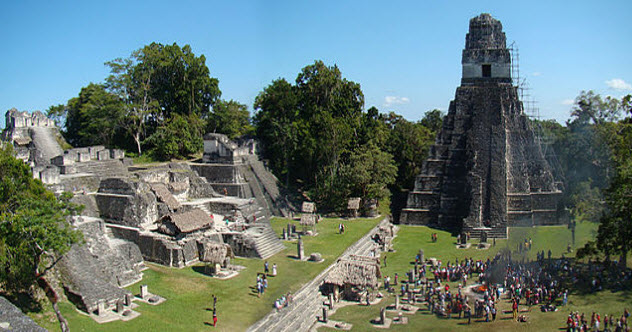
The classic Mayan civilization stretched from the Yucatan Peninsula of Mexico through Belize, Guatemala, and northern Honduras. This was difficult terrain, prone to drought and soil erosion. Yet here the Maya built one of the great civilizations of ancient America, mastering writing and mathematics. (They arguably invented zero before anyone else).
Unlike the Aztecs or Toltecs, the Maya were never united in one empire. Instead, they formed a squabbling network of city-states, not unlike ancient Greece. Warfare was limited and somewhat ceremonial. Trade was extensive.
The cities of Calakmul and Tikal grew particularly wealthy. Both dominated large areas of fertile territory and had access to chert mines. They traded in jade, obsidian, feathers, and other tropical luxuries, and their priests and merchants grew rich on the profits. During the reign of King Chak Tok Ich’aak, Tikal surpassed Calakmul and reached new heights of splendor and prestige.
Yet Chak Tok Ich’aak’s success was also at the root of his downfall. Even as Tikal’s palaces and monuments rose more splendid than ever before, the city’s wealth attracted attention from far beyond the Mayan lands. In the distant highlands of central Mexico, powers vast and cool and unsympathetic regarded Tikal with envious eyes and slowly drew up plans against it.
9The Invasion
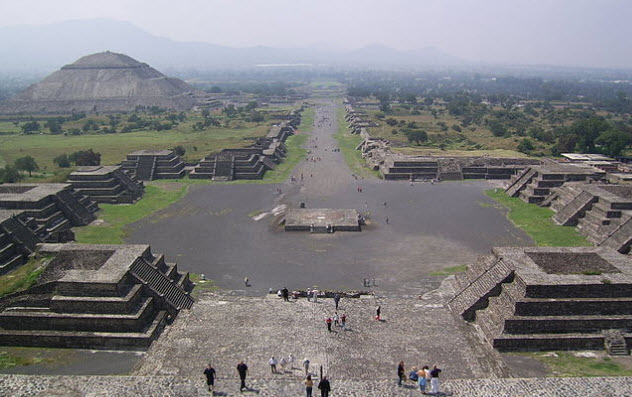
Over 1,000 kilometers (600 mi) from Tikal in the Valley of Mexico near what is now Mexico City, an immense and mysterious city rises. We still don’t know who built it or how to read their language. We don’t even know its real name. The Aztecs, who wandered awed through the ruins a millennium later, dubbed it Teotihuacan, “the place where men become gods.”
It’s understandable that the Aztecs were impressed because Teotihuacan was huge. Its population was well over 100,000, making it easily the largest city in the Western Hemisphere at the time. Its monuments were gargantuan: The Pyramid of the Sun is one of the largest ever built, and the Pyramid of the Moon is only slightly smaller. The Street of the Dead runs for 2.5 kilometers (1.5 mi) between the main temples. Its warriors roamed far and wide, distinguished by their unusual shell goggles and the obsidian mirrors strapped to their backs.
Immigrants from all over Central America flocked to Teotihuacan, turning it into a melting pot of different cultures and languages. From atop the pyramids, a priestly class occasionally carried out human sacrifices. The city’s political structure remains subject to debate, but by the AD 370s, it seems to have been under the control of a powerful figure known as Spearthrower Owl. In 378, he watched as his army marched out of Teotihuacan and headed east for Tikal.
8‘Fire Is Born’
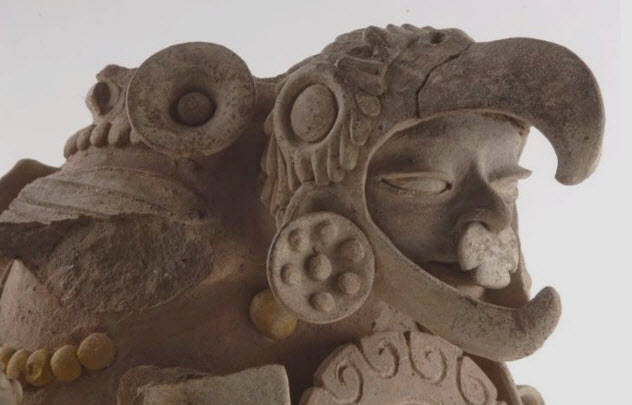
Spearthrower Owl didn’t accompany the army himself. Instead, it was commanded by a general the Maya called Siyaj K’ak’ (“Fire Is Born”). They also dubbed him “Ochk’in Kaloomte” (“Lord of the West”), reflecting his origins in Teotihuacan. Mayan cities quailed as his army passed, and at least four of them seem to have recorded the event in murals depicting elaborately costumed and heavily armed Teotihuacano warriors. They easily stand out compared to the Maya, who are depicted in simple breechcloths and headdresses.
In January 378, Siyaj K’ak’ appeared in Waka’, a town just west of Tikal. Exactly eight days later on January 14 (8.17.1.4.12 on the Mayan calendar), he arrived in Tikal. In their helmets and goggles, the warlike Teotihuacanos must have been a fearsome sight and Chak Tok Ich’aak was apparently unable to mount any meaningful resistance. Siyaj K’ak’ forced his way into the palace that very same day, and King Chak Tok Ich’aak “entered the water” of the Mayan afterlife. We can assume that he was either quietly murdered or encouraged to commit suicide.
Siyaj K’ak’ presumably had the dead king’s family murdered as well. (They certainly disappear from the historical record immediately afterward). His soldiers also broke or damaged all of Tikal’s preconquest monuments and inscriptions. A year after the invasion, Spearthrower Owl’s son came down from Teotihuacan and was crowned the new king of Tikal.
7Building An Empire
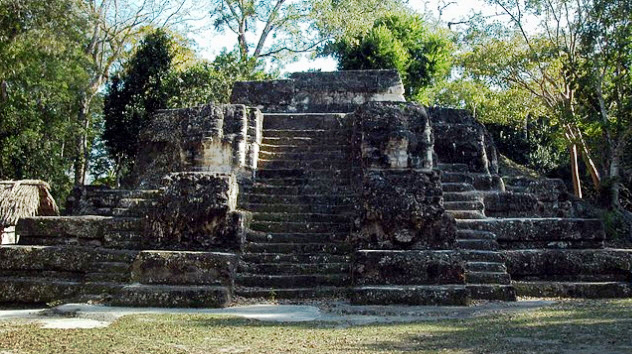
While Spearthrower Owl’s son sat on the throne, Siyaj K’ak’ continued to expand his new empire. Shortly after the conquest of Tikal, the city of Uaxactun seems to have been overrun and made part of the Tikal kingdom. Stelae in the city depict heavily armed Teotihuacan warriors, and historians believe these show Siyaj K’ak’ conquering the city. Archaeologists found five murdered noble women and children buried beneath one of the stelae—the slaughtered family of Uaxactun’s last king.
In 393, Siyaj K’ak’ marched into Rio Azul, a city in what is now Guatemala. Clearly, the Maya remained no match for his goggled warriors. An altar depicts the sacrifice of eight members of the city’s old ruling class, and Rio Azul became subject to Tikal. This was a huge victory since Rio Azul lay on the River Hondo, a crucial trade route to the Caribbean coast. The city’s conquest secured this route and allowed Tikal to suck trade away from rival cities like Calakmul.
At some point, Siyak K’ak’ also seems to have installed a new ruling family in the famed Mayan city of Palenque. As a new Mayan calendar cycle approached (the year 9.0.0.0.0 was in 435 AD), it seemed that Teotihuacano-Tikal was poised to dominate the entire Mayan world.
6Tikal Consolidates Power
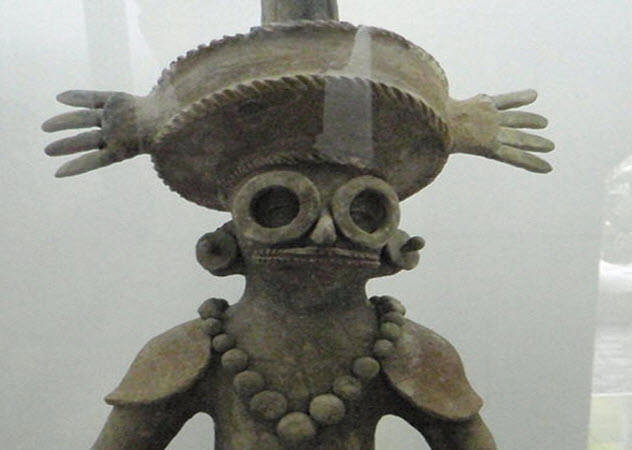
Spearthrower Owl’s son died in AD 411, and Siyaj K’ak’ presumably passed away a few years earlier. The new king of Tikal was Spearthrower Owl’s grandson, Siyaj Chan K’awiil II, who tried to consolidate the new kingdom by appealing to his Mayan subjects. His monuments and murals depict him in Mayan dress and emphasize his Mayan mother. Even his name was taken from an earlier Mayan ruler of Tikal rather than his Teotihuacano ancestors.
But that doesn’t mean he tried to hide his central Mexican roots. While Siyaj Chan K’awiil had himself depicted in Mayan costume, he kept Spearthrower Owl’s glyph on his crown. In several monuments, Siyaj Chan K’awiil sits in Mayan dress while the spirit of his father looks on wearing full Teotihuacan military gear. This must have been an effective propaganda campaign: “I’m one of you,” the monuments declared, “but remember the power I have behind me.”
Meanwhile, “New Tikal” continued to expand. In 426, Siyaj Chan K’awiil raised a warrior known as K’inich Yax K’uk’ Mo’ to the rank of king and sent him to seize the city of Copan in what is now Honduras. K’inich Yax K’uk’ Mo’ also conquered the city of Quirigua, giving the Tikal-Copan entity control of the entire Motagua Valley. Under Siyaj Chan K’awiil’s immediate successors, Tikal continued to expand and consolidate its dominant position. And it seemed the other Mayan cities could only look on in fear and jealousy.
5The Star War
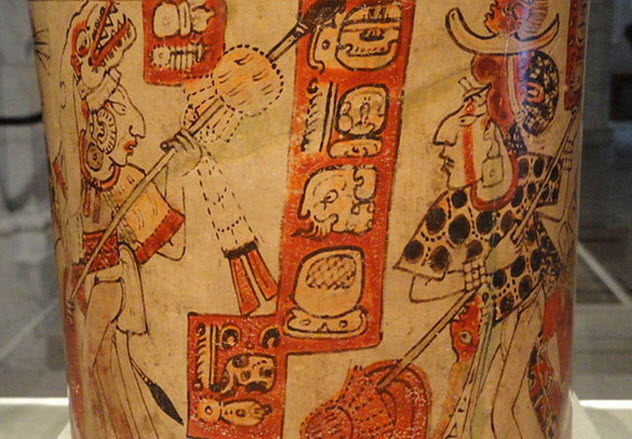
Today, the temples of Calakmul rise like icebergs out of the immense jungles of Campeche. But in its heyday, the city ruled one of the largest and most powerful Mayan kingdoms. It was the home of the Kaan dynasty, a particularly long-lasting and resourceful family of priest-kings who had relocated to Calakmul after their ancient power base at El Mirador went into decline.
After the Teotihuacanos arrived, the Kaan watched helplessly as they were eclipsed by the rising power of Tikal. (The conquest of Rio Azul was a clear attempt to cut Calakmul out of the rich Caribbean trade routes). But as time passed, the Maya began to master central Mexican weapons like the spear-thrower and Tikal’s warriors began to lose their mystique.
But Tikal remained too large and powerful for Calakmul to challenge head-on. So a Kaan ruler known as Sky Witness decided to outflank it instead. Doubtless appealing to Mayan solidarity and jealousy of the Teotihuacanos, Sky Witness constructed a delicate alliance of Mayan cities surrounding Tikal. The noose was complete by 556 when Tikal’s most powerful vassal, the huge city of Caracol, betrayed it to join the alliance. Between Calakmul in the north and Caracol in the south, Tikal was caught in a pincer.
After years of strangling Tikal, Sky Witness decided to finish it. In 562, Calakmul and Caracol launched a “Star War.” This was basically the Mayan equivalent of total war: The aim was to completely crush the opposing state. Their combined armies overran Tikal, defaced its monuments, and ritually sacrificed its king. It was a huge victory. But things weren’t over yet.
4The Wrath Of Kaan

The Kaan were unimaginably ancient and power-hungry. From the great city of El Mirador, they had been at the forefront of the preclassic period of Mayan history, and now Calakmul looked set to dominate the classic period. After defeating Tikal in 562, they installed a puppet king and an onerous peace agreement. For the next century, no new monuments were permitted in Tikal and much of the city’s wealth was siphoned off to Calakmul.
Shortly afterward, the Kaan destroyed Rio Azul, cementing their control of the Rio Hondo trade. They also probably attacked Copan, whose monuments were destroyed or defaced during this period. The Kaan ruler Scroll Serpent lead a huge expedition to distant Palenque where he executed the king, a descendant of the ruler put in place by Siyaj K’ak’ all those years ago. No challenge to Sky Witness’s alliance was allowed. When the city of Naranjo tried to leave the alliance to attack Caracol, the Kaan ransacked it and tortured its king to death.
But Tikal’s size and resources meant it remained a potential threat, and the Kaan watched it like a hawk for any sign of defiance. In 629, Tikal tried to found a new city at Dos Pilas. In response, the Kaan invaded and forced the ruler of Dos Pilas (the king of Tikal’s own brother) to become a vassal of Calakmul instead. But they were never able to fully destroy Tikal, which remained a sleeping giant waiting to be awakened.
3Tikal Turns The Tide
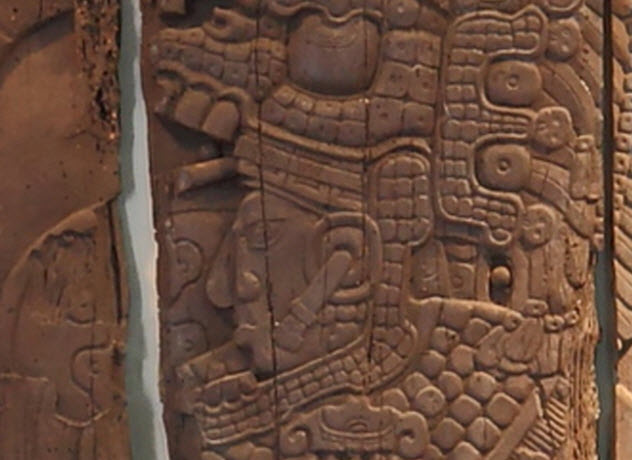
In 682, a new king rose to the throne in Tikal. Jasaw Chan K’awiil was possessed by an iron determination to restore Tikal’s power. As a child, he had seen his father humiliated by Calakmul and Dos Pilas. But he also sensed that the Calakmul alliance was weakening. As soon as he took the throne, he began work on giant monuments and inscriptions, the first in Tikal for over a century.
Tikal’s situation was precarious: The city was still surrounded by the great ring of the Calakmul alliance, including El Peru in the west, Naranjo in the east, Dos Pilas and Caracol in the south, and Masaal and Calakmul in the north. Faced with this formidable league, Jasaw Chan K’awiil decided on a bold roll of the dice. Bypassing the smaller cities, he launched a surprise attack on Calakmul itself. In 695, his army “brought down the flint and shield” of Calakmul and won a dramatic victory.
Jasaw returned to Tikal covered in glory and held a great triumph on the anniversary of Spearthrower Owl’s death. A carving of the event from Tikal’s royal palace shows Jasaw bedecked in full Teotihuacan military gear, looming triumphantly over an imprisoned Kaan lord being prepared for sacrifice.
With Calakmul on the back foot, Tikal’s rulers set about dismantling the alliance that hemmed them in. Jasaw himself subdued Masaal in the north while his son, Yik’in Chan K’awiil, defeated El Peru and Naranjo in a single year-long campaign. Yik’in Chan K’awiil also launched another attack on Calakmul itself, capturing and sacrificing the Kaan ruler.
However, Dos Pilas in the south remained stubbornly defiant, defeating a Tikal invasion force in 705. That must have particularly hurt because Dos Pilas was still run by a distant branch of Tikal’s ruling family.
2A Tropical Cold War
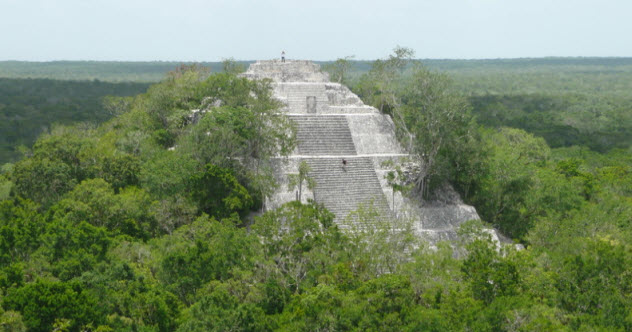
With the alliance broken, Calakmul watched jealously as Tikal’s wealth and power grew. But neither city was ever able to completely destroy the other. This period of Mayan history has been compared to the Cold War, with the two superpowers warily watching each other and engaging in numerous skirmishes and proxy wars.
For example, Tikal had been allied with Copan since it was conquered by K’inich Yax K’uk’ Mo’ (see entry 6). K’inich Yax K’uk’ Mo’ had also conquered the city of Quirigua and made it a vassal of Copan. But in 738, the Kaan encouraged Quirigua to revolt. With support from Calakmul, the Quiriguans seized and decapitated Copan’s king, severely weakening Tikal’s most important ally.
Such proxy wars became increasingly common as Tikal and Calakmul repeatedly invaded neighboring cities to put friendly rulers on the throne. Without confronting each other directly, their fortunes ebbed and flowed and the records of neighboring cities are full of nervous mentions of the two titans. Teotihuacan had long since declined, and Spearthrower Owl was forgotten in the Valley of Mexico. But in the Yucatan, his descendants fought on against the ancient snake glyph of the Kaan.
Warfare became increasingly common and frantic across the region. As Calakmul’s sphere of influence receded, Dos Pilas lost control of its vassals and the Petexbatun region descended into complete chaos. The people of Dos Pilas tore down their temples to build defensive walls while the ruling family (still distant relations of Tikal’s kings) fled to the fortress of Aguateca, guarded by a mighty ravine. At Punta de Chimino on Lake Petexbatun, the people built a formidable network of walls and moats. But the fighting was terrifyingly intense, and both Aguateca and Punta de Chimino were stormed and destroyed.
Meanwhile, both Calakmul and Tikal continued to grow. The city of Calakmul alone now housed more than 120,000, with larger numbers in its surrounding kingdom. But there were already signs of decline. As the centers struggled to hold on, things were falling apart.
1The Great Collapse
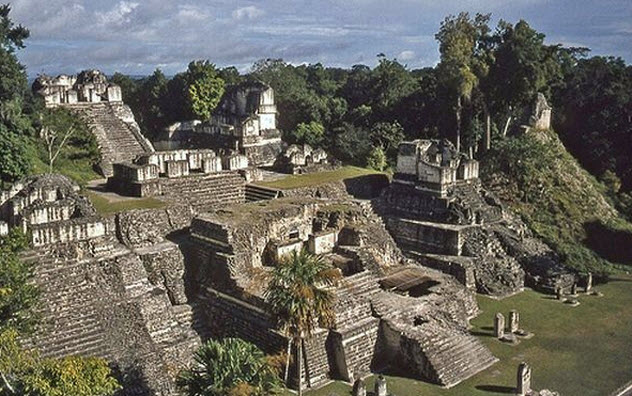
Beginning at the start of the ninth century AD, the classical Mayan civilization dramatically collapsed. The great cities of the lowlands lost most of their population or were abandoned entirely, to be swallowed up by the jungle. The great dynasties vanished, and monuments and temples fell into ruins. Mayan civilization continued in the north in trading towns like Chichen Itza, dominated by merchants rather than autocratic priest-kings. But the era of sprawling cities and huge building projects was over.
The reasons for this collapse remain one of the great mysteries of history. We now know that it coincided with a period of sustained drought, which almost certainly played a role. Probably the land could no longer sustain the huge population. Tikal, for example, built huge reservoirs to keep the city going through the four-month dry season. But years of low rainfall would have defeated even Mayan ingenuity. However, drought alone can’t explain the collapse—the cities of the north lasted far longer than those of the lowlands, even though the north was much drier.
Whatever the reason, the collapse finally ended the 400-year conflict between Tikal and Calakmul. Locked in their titanic struggle, the two cities probably never saw it coming. The war almost certainly sapped the Mayan ability to respond to the catastrophe facing them. Calakmul was one of the first cities to go, losing all cohesion by about AD 810. Tikal held on for another 50 years, but eventually, it was abandoned, too. The sons of Spearthrower Owl and the Kaan dynasty disappeared from history.
After the collapse, a small population hung on in Calakmul and occasionally erected crude monuments in imitation of their ancestors. But the writing inscribed on them was nonsensical. They no longer remembered how to write.

